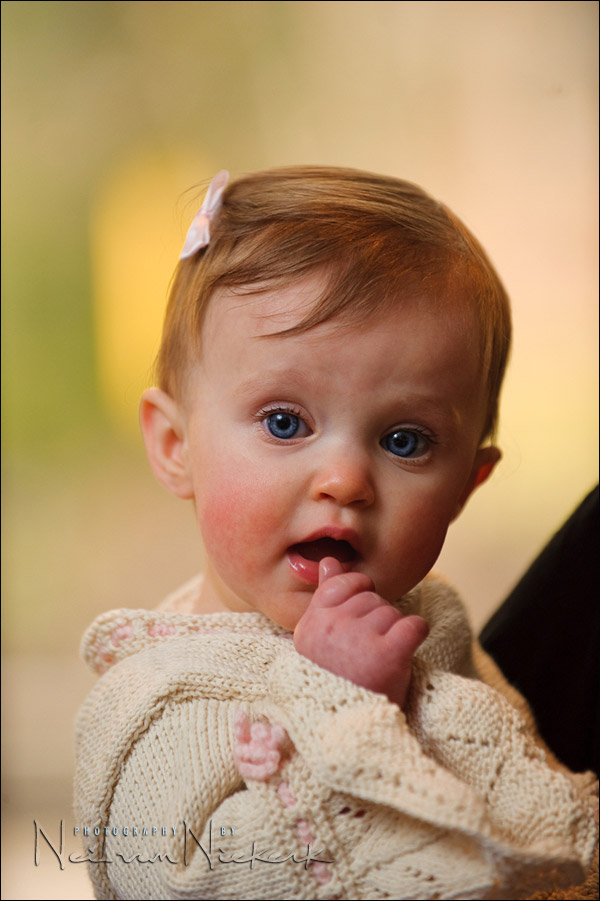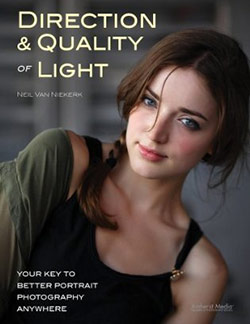
Bounce flash – balancing foreground and background exposure
Lighting for the impromptu portrait of this little cutie was simple – just an on-camera speedlight, bounced up and over my left shoulder. This gives soft directional light. A simple technique that works every time when using on-camera flash indoors where there are light ceiling and walls around.
Settings: 1/250th @ f4 @ 1000 iso; TTL flash
My exposure settings was determined by the out-of-focus garden area outside, seen through a large window. It was over-cast, and therefore not super-bright. This meant that the bounce flash had a chance at balancing my exposure for my subject, with that of the background.
This little girl’s mom asked me for a few quick portraits of the two of them. So to keep the background simple (and avoid the other guests and the food tables in the frame), I had her hold her baby with the two of them standing in front of (but away from) a large window. The green in the background are the out-of-focus trees outside. The yellow patch is a reflection of one of the tungsten spotlights in the ceiling inside the room. In composing this portrait, I purposely positioned the out of focus yellow highlight right there.
This is when it all comes together for a simple and effective portrait – the expression (or moment), deliberately combined with a complementing background and beautiful light. And this is the point I wanted to make with this post .. look at your background. Move yourself and move your subject until your background, at the very least, isn’t distracting. But better yet, look at the background and frame your subject such that the background enhances the image.
Direction & Quality of Light
I wanted to distill the essence of what we, as photographers, work with – light! Before we can truly grasp on-camera flash and off-camera flash, and really, any kind of photography, we have to be aware of the direction and quality of light. We need to observe the light that we have, and then decide how best to use it, or enhance it.
With this book, I try my best to share those “aha!” moments with you, and I do believe this book can make a difference to your photography.
The book is available on Amazon USA and Amazon UK, or can be ordered through Barnes & Nobles and other bookstores. The book is also available on the Apple iBook Store, as well as Amazon Kindle.

Hi
I’ve been trying the on-camera speedlight, bounced up and over my left shoulder thing with TTL on the SB900, and even though I am in a normal room with low ceilings, I find sometimes I get correct exposure, sometimes need to set FEV +/- in the same room!
How does TTL work? Does it use the same metering modes, and if I use center-weighted as you suggest you usually use, then if I half-press and recompose would it be incorrect since the center during pre-flash is not my subject anymore?
Also, EV does seem to have an effect even in manual mode in Nikons, so since it’s manual, what do I set, EV or FEV?! or both?!?!
Beautiful little girl with BEAUTIFUL big blue eyes! Her Mum would have loved that shot!
Can you get the background that OOF with the D40 kit lens? I struggle to see much more than a slight blur and it just looks like I’ve focused wrongly even at max aperture.
How do you increase blur? Get closer to subject and have background further away?
Nice blog!
Jas
Hi Neil
I am just starting to explore this over the shoulder bounce type of flash.
I was wondering about the catch light in her eye was this done in post??
Great shot and I really like your site.
John
Neil:
Very nice shot as usual. As someone who can’t afford a D3, the D80 gets a little noisy at ISO 1000. Assuming I exposed for your background using a slower shutter speed and therefore lower ISO, would an SB600 flash be strong enough to light the cutie at f4 and still give me the same shot? I was thinking that 1/80 @ f4 320iso. i suppose that it would also depend on how far away you were from the wall you bounced off of?
Thanks for continuing to post and taking the time and interest to explain and demonstrate your great work. Much appreciated and I am always tuning in.
Hi Neil,
Lovely photo. With regards to the background comments you mentioned, I always feel ‘rushed’ and like I have no time to search all over for effective backgrounds as they relate to the overall composition. I most certainly attempt to avoid distracting backgrounds, but by the time one plays around with lighting and figures out the background just isn’t cutting it I am worried the subject will begin to get annoyed if I change locations five times to find that ‘right’ background. I am guessing it simply comes down to skill in creating compelling photographs.
My personal work doesn’t bother me as I will take all the time I need to set up a photo, but for something like this or weddings where time is of the essence I seem to struggle being able to create that ‘perfect’ photo. Again, skill and experience is the answer to be able to spot those backgrounds that will be conducive to creating those great images. I can’t yet seem to be able to create a photograph clear enough in my mind before I commit it to the camera.
It is sometimes frustrating to have people standing there looking at me and expecting that I can make amazing photographs in the blink of an eye without some tinkering, adjusting, and changing locations in order to give them what they are expecting. Any tips on how to effectively deal with people as I ‘muck’ around to get those better photos?
What lens did you use? I assume it was a longer focal length?
I used the Nikon 70-200mm f2.8 AF-S VR lens, and it was zoomed to 200mm
Neil,
When capturing a shot like this, do you meter for a correct exposure on the background, or the childs face?
Edward, in this case I set my camera to expose for the background as I wanted, and then I let the TTL flash metering technology take care of the flash exposure.
This is very similar to the recent posting on ambient exposure with TTL flash.
Mac, may I allow myself to comment on your question? Doesn’t a layman always expect instant miracles from a professional, regardless of his or her area of expertise? First, admit to yourself that you won’t be able to deliver such a thing. Second, act accordingly. In the field of photography, this would mean: find a good place for your subject, a suitable white wall to bounce your flash at, a decent background and start taking pictures. Then immediately say something really positive like “Great! Now let’s have some pictures with the light coming in from your left” and shamelessly repeat the entire procedure until you run out of ideas. You will appear to be a creative person and your memory card will probably contain a couple of nice portraits because even though you are not selling instant miracles, you are still a photographer.
Wow, love this picture a lot, the background color is so beautiful.
Neil,
I have been reading many of your blogs and find your concepts extremely interesting and helpful. I am curious as to your thoughts in the situation where walls or easy bounce structures are not available. Perhaps you have written on this, but I have not seen it yet. Thanks for the guidance.
Nice to know you can get great results with a speedlite.
sooooo cute. she is going to bless you for taking this picture 10 years from now.
Hi Neil
Great Picture. You said that the settings were
Settings: 1/250th @ f4 @ 1000 iso; TTL flash
and you used the 70-200mm 2.8 lens.
Why not keep Aperture at 2.8 to get the more shallow DOF as she is the only one in the frame . Was the choice of f/4 due to the fact that most lenses are most sharp at 2 stops above the largest aperture.
Thanks.
-MP
Neil,
I would like to know how you came up with the similar settings for that shot you did. Example: 1/250@2.8@500 ISO= 1/200@2.8@400 ISO. Is there a formula that you could send me?
Would 1/250 @ 2.8 be the same as 1/125 @ f4 ?
Neil,
Great photo and write-up !
To answer some of the questions regarding DOF, Neil’s FF D3 has a little more than 1 f-stop more shallow DOF than a 1.5x (Nikon) or 1.6x (Canon) cropped body does.
So, the cropped equivalent of Neil’s EXIF would be around f/2.6, roughly ISO 450, with a focal length of around 130mm. f/2.8 @ ISO 500 would do nicely.
source : https://www.cambridgeincolour.com/tutorials/digital-camera-sensor-size.htm
Neil,
Fantastic shot and a beautiful child. Did you use your foam snoot when you shot your flash over shoulder? If so why? If not, Why?
Thanks,
Brian
Thanks Neil. I still have the one from your seminar..
Shall I send it in for a factory modification……
Thanks again Neil. So the catchlight is from the wall/ceiling, etc that the bounce comes from. Any way to get a catchlight when the flash is just being bounced more generally into a large room? There are times when the bounce is not going to get the softbox effect (though when I looked closely at some recent bounce stuff I’ve done, I did see catchlights, often just smaller than a softbox in close would give. But it doesn’t take much to bring a little life to the eyes.
If I put a small strip of white of silver tape on the inside of the half snoot, would that work to not so much kick light toward the subject as give a point to get a specular in the eye? I know I can (and will) try this for myself. Much of my family has very dark eyes and without a catchlight they really seem to recede.
BTW– the comment immediately above with a ref to your seminar is NOT from me…in case you were puzzled by the non sequitur.
Also, any plans to return to the Raleigh/Charlotte for a seminar? Was out of town when you last came here and am hoping you’ll be local (to me) again. Thanks.
I do not have such a good camera and lens as you have. I only have the standard Fujifilm S100FS and a CyberTik MZ45 flash. I will have noticible noises if above ISO-800.
If the room you bounced the flash is big, then my small MZ45 may not have the power to bounce back enough light for this shot you took. I have not tried this trick yet.
Would 1/60, f3.6, ISO800 do the same trick? (Why f3.6 is because at zoom, my aperture becomes smaller even though it is rated 2.8)
Hi Neil
Could you tell me why you feel it’s important to keep to the 1/3rd of a stop step values please?
I guess I’m a little old school; when I first got my D300 I changed the custom setting to 1/2 stops as they made more sense, recently I changed to “whole” stops as I can get my head around them far more easily – however, I’m quite sure there is a very good reason not to go down this route?!
Regards,
James